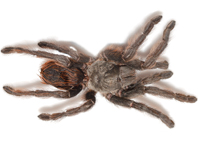Abstract
Deckert described a Tomopterna as Arthroleptella ahli from South Africa in 1938. We demonstrate that the type of Tomopterna ahli (Deckert, 1938) was actually collected in Namibia, and that this nomen is a senior synonym of Tomopterna damarensis Dawood & Channing, 2002. We designate a neotype for Tomopterna ahli (Deckert, 1938).
References
Baker, M. (2007) Ludwig Krebs—A naturalist’s observations of the Sixth Frontier War, 1834–5. Military History Journal, 14, 63–66.
Bauer, A.M. (2004) Early German herpetological observations and explorations in southern Africa, with special reference to the Zoological Museum of Berlin. Bonner zoologische Beiträge, 3–4, 193–214.
Bischoff, W. (2001) L.V. Martin Heinrich Lichtenstein (1780–1857). In: Rieck, W., Hallmann, G. & Bischoff, W. (Eds.), Die Geschichte der Herpetologie und Terrarienkunde im deutschsprachigen Raum. Mertensiella, 12, 1–756. [pp. 521–523]
Ceríaco, L.M.P., De Sá, S.d.A.C., Bandeira, S., Valério, H., Stanley, E.L., Kuhn, A.L., Marques, M.P., Vindum, J.V., Blackburn, D.C. & Bauer, A.M. (2016) Herpetological survey of Iona National Park and Namibe Regional Natural Park, with a synoptic list of the Amphibians and Reptiles of Namibe Province, southwestern Angola. Proceedings of the California Academy of Sciences, Series 4, 63, 15–61.
Dawood, A. & Channing, A. (2002) Description of a new cryptic species of African sand frog, Tomopterna damarensis (Anura: Ranidae), from Namibia. African Journal of Herpetology, 51, 129–134.
https://doi.org/10.1080/21564574.2002.9635468
Deckert, K. (1938) Beiträge zur Osteologie und Systematik ranider Froschlurche. Sitzungsberichte der Gesellschaft Naturforschender Freunde zu Berlin, 1938, 127–184.
Frost, D.R. (2019) Amphibian Species of the World: an Online Reference. Version 6.0. Museum of Natural History, New York. Available from: http://research.amnh.org/herpetology/amphibia/index.html. American (accessed 13 June 2019)
Giess, W. (1972) Der Botanischen Garten auf der Farm Lichtenstein bei Windhoek im Jahre 1922. Dinteria, 7, 13–15.
Günther, R. (2001) Zur Geschichte der herpetologischen Sammlung des Museums für Naturkunde Berlin. In: Rieck, W., Hallmann, G. & Bischoff, W. (Eds.), Die Geschichte der Herpetologie und Terrarienkunde im deutschsprachigen Raum, Mertensiella, 12, 1–756. [pp. 359–374]
Heinicke, M.P., Ceríaco, L.M.P., Moore, I.M., Bauer, A.M. & Blackburn, D.C. (2017) Tomopterna damarensis (Anura: Pyxicephalidae) is broadly distributed in Namibia and Angola. Salamandra, 53, 461–465.
Herre, H. (1972) Erinnerungen an Professor K. Dinter. Dinteria, 7, 9–12.
IUCN (2019) The IUCN Red List of Threatened Species. Version 2018-2. Available from: http://www.iucnredlist.org (accessed 14 January 2019)
Kunze, F. (1909) Einige Notizen über die Säugetier- und Vogelfauna von Deutsch-Südwestafrika, gesammelt 1906–1907. Zoologische Beobachter, 50, 11–20.
Landsberg, H. (2010) Vom „Hottentottenarzt“ zum Museum- und Zoodirektor— Hinrich Lichtenstein. In: Damaschun, F., Hackethal, S., Landsberg, H. & Leinfelder, R. (Eds.), Klasse, Ordnung, Art—200 Jahre Museum für Naturkunde. Basilisken-Presse, Rangsdorf, pp. 118–121.
Leistner, O.A. & Morris, J.W. (1976) Southern African Place Names. Annals of the Cape Provincial Museums, 12, i–iv + 1–565.
Loveridge, A. (1957) Check list of the reptiles and amphibians of East Africa (Uganda; Kenya; Tanganyika; Zanzibar). Bulletin of the Museum of Comparative Zoology, 117, 153–362 + i–xxxvi.
Marques, M.P., Ceríaco, L.M.P., Blackburn, D.C. & Bauer, A.M. (2018) Diversity and distribution of the amphibians and terrestrial reptiles of Angola. Atlas of historical and bibliographic records (1840–2017). Proceedings of the California Academy of Sciences, Series 4, 65 (Supplement II), 1–501.
Ohler, A. & Frétey, T. (2008) Statut du nom Arthroleptis milletihorsini Angel, 1922 (Amphibia, Anura). Alytes, 25, 173–175.
Paepke, H.-J. (1988) In memoriam Kurt Deckert (1907–1987). Mitteilungen aus dem Museum für Naturkunde in Berlin. Zoologisches Museum und Institut für Spezielle Zoologie, Berlin, 64, 195–198.
https://doi.org/10.1002/mmnz.19880640202
Plug, G. (2014) Krebs, Mr Georg Ludwig Engelhard. S2A3 Biographical database of southern African science. Available from: http://www.s2a3.org.za (accessed 1 October 2019)
Poynton, J.C. (1964) The Amphibia of southern Africa: a faunal study. Annals of the Natal Museum, 17, 1–334.
Rödel, M.-O. & Hallermann, J. (2006) Rediscovery and identity of Phrynobatrachus monticola Fischer, 1884. African Journal of Herpetology, 55, 69–74.
https://doi.org/10.1080/21564574.2006.9635540
Skead, C.J. (1973) Zoo Historical Gazetteer. Annals of the Cape Provincial Museums, 10, 1–259.
Sprigade, P. & Moisel, M. (1904) Kriegskarte von Deutsch-Südwestafrika. Blatt Windhuk. Dietrich Reimer, Berlin. [map]
Swofford, D.L. (2002) PAUP*. Phylogenetic Analysis Using Parsimony (*and Other Methods). Version 4. Sinauer Associates, Sunderland, Massachusetts.
Trigonometrical Survey Office, (1972) South Africa 1: 250 000 Topographical Sheet 2116 Okahandja. 1st Edition. Government Printer, Pretoria.
Zimkus, B.M. & Larson, J.G. (2011) Examination of the molecular relationships of sand frogs (Anura: Pyxicephalidae: Tomopterna) and resurrection of two species from the Horn of Africa. Zootaxa, 2933 (1), 27–45.
https://doi.org/10.11646/zootaxa.2933.1.2

